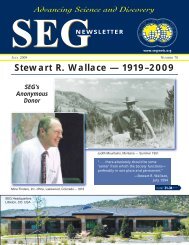Download - Society of Economic Geologists
Download - Society of Economic Geologists
Download - Society of Economic Geologists
You also want an ePaper? Increase the reach of your titles
YUMPU automatically turns print PDFs into web optimized ePapers that Google loves.
APRIL 2006 • No 65 SEG NEWSLETTER 9... from 1The Mineral Exploration Business: Innovation Required (Continued)Battle Mountain, Cyprus, Homestake,Lac, Magma, MIM, Noranda, Normandy,North, Rio Algom, Santa Fe,and, most recently, Placer Dome. Thenumber <strong>of</strong> new names is far fewer,Xstrata being the only significant one.This consolidation began with thefall in exploration expenditures fornonferrous minerals exploration from1997 to 2002, and somewhat surprisingly,has continued as explorationbudgets have climbed back to their1997 levels (Fig. 1; Metals <strong>Economic</strong>sGroup, 2005a, b). The so-called juniorsector, an important generator anddiscoverer <strong>of</strong> new projects, sufferedseverely after the Bre-X scandal in1997, the subsequent diversion <strong>of</strong>investment into the technology boom,and the pr<strong>of</strong>ound depression <strong>of</strong> metalsprices. The loss <strong>of</strong> exploration budgetsas a result <strong>of</strong> mergers has been<strong>of</strong>fset by a strong revival since 2003 inthe junior sector.Although the substantial six-yeardecline in exploration spending doesnot appear to have had much effect onexisting production, the decline in newdiscoveries moving up the pipeline willprobably significantly reduce new minedevelopment in the near future. Theconsensus <strong>of</strong> senior executives at theReuters Mining Summit was that thereis serious lack <strong>of</strong> good new projects <strong>of</strong>the kind that last for decades and makea company’s fortune. Donald Lindsay,Chief Executive <strong>of</strong> Teck Cominco,expects “the scarcity <strong>of</strong> good explorationprojects to become a serious issuein three to five years from now”(Industry Outlook, InternationalMining, September 2005, p. 29–30). Ithas been pointed out that there arelarge, unexploited gold resources available,if the gold price is right (Burton,2003). However, the quality <strong>of</strong> thesedeposits in terms <strong>of</strong> grade, metallurgy,infrastructure, and legal-fiscal regimesis <strong>of</strong>ten suspect. Indeed, Barrick’s golddiscovery at Alto Chicama in Peru illustrateshow a near-surface oxide golddeposit in a favorable mining country ispreferable to lesser quality orebodieselsewhere despite their availability. Interms <strong>of</strong> copper exploration, the availableresources around brown-field sitesin the advent <strong>of</strong> better prices is vast,and thus the exploration for new copperdeposits must take this into account:the question is, are there quality targetsto compete? Zinc is very much in a$6,000$5,000$4,000$3,000$2,000$1,000$01996 1997 1998 1999 2000 2001 2002 2003 2004 2005FIGURE 1. Global exploration budgets for nonferrous metals, estimated totals in US$ million(Metals <strong>Economic</strong>s Group 2005a, b).similar position, although the view isthat zinc oxide deposits (technologydriven) are the way forward.Clearly, there is always going to be ademand for new, quality projects,because the major mining houses muststrike a balance between growth strategies<strong>of</strong> exploration versus acquisition—the product they deal in is finite andhas to be replaced. This bodes well forcompanies involved in E&D, especiallyfor successful ones capable <strong>of</strong> providingreturns for investors on a par with, oreven better than, the high-technologyand dot.com sectors. Interestingly,despite phenomenal returns forinvestors in these sectors, the inabilityto be pr<strong>of</strong>itable drove them into a spectaculardecline.THE BUSINESS OFEXPLORATION:MEASURING SUCCESSIn order to determine whether or notexploration is pr<strong>of</strong>itable, exploration asa cost item must be compared with thereturn generated as a result <strong>of</strong> thisexpenditure (Doggett, 2000). This comparisonis complicated by the long-termnature <strong>of</strong> exploration. In even the mostfavorable geological environments, itwill take, on average, several years todiscover and delineate an economicmineral deposit—the basis for calculatingreturns from exploration. In thisrespect, there is clearly a need toshorten the time frame <strong>of</strong> exploration toallow the returns to be seen by the relevantcompany and the investor.The most direct evidence that explorationis pr<strong>of</strong>itable in the long term isprovided by the survival and growth <strong>of</strong>individual companies (Doggett, 2000).From the perspective <strong>of</strong> the explorationindustry, the market should provide anindication <strong>of</strong> actual and expected pr<strong>of</strong>itsthrough valuation <strong>of</strong> explorationcompanies and availability and cost <strong>of</strong>funds required for exploration. Theaverage cost <strong>of</strong> exploration should notexceed the average return from exploration.From a corporate perspective,this is the bottom line for survival. If thepr<strong>of</strong>its from the development and production<strong>of</strong> economic deposits do notoutweigh the costs <strong>of</strong> finding (or acquiring)them, then economic ruin will bethe long-term outcome.Yet E&D companies that do notdevelop and produce cannot use revenueas a measure <strong>of</strong> success. Survivalis about securing funding and beatingthe probability <strong>of</strong> failure—in otherwords, continual discovery.Given the importance <strong>of</strong> R&D inother business sectorsand its high cost, manyto pagecompanies struggle to 10 ...






